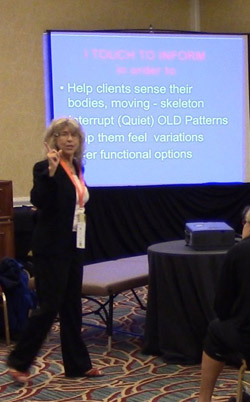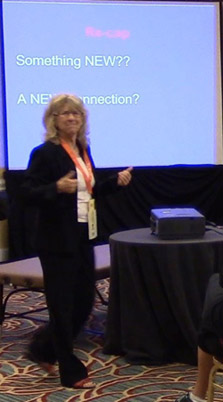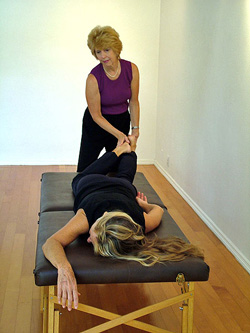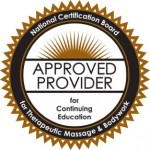TOUCH TO INFORM SEMINARS
A FULL CERTIFICATE PROGRAM
a Feldenkrais® Model for Sensory Learning CE’s for LMTs
 Continuing Education Programs for educators, coaches and therapists (LMTs) using concepts and practical applications from The Feldenkrais Method® developed by Bonnie Kissam, M.A. in Dance/Education, LMT, Feldenkrais Practitioner/Assistant Trainer, Licensed Massage Therapist, FL Lic #MA 36256, Florida CE Provider # 50-1980, NCBTMB Provider # 452056 Collaborated with Nikki Rollason, Feldenkrais Practitioner, Licensed Massage Therapist, FL Lic. #MA 31953 from Miami, FL.
Continuing Education Programs for educators, coaches and therapists (LMTs) using concepts and practical applications from The Feldenkrais Method® developed by Bonnie Kissam, M.A. in Dance/Education, LMT, Feldenkrais Practitioner/Assistant Trainer, Licensed Massage Therapist, FL Lic #MA 36256, Florida CE Provider # 50-1980, NCBTMB Provider # 452056 Collaborated with Nikki Rollason, Feldenkrais Practitioner, Licensed Massage Therapist, FL Lic. #MA 31953 from Miami, FL.
- Think of the skeleton as support and a useful tool for reducing muscular tension.
- Understand the neurological components to FEAR and the relationship to tension.
- Use ‘learning’ to improve breathing capacity for lifelong posture.
- Use a synergistic integrated view of muscular patterns to guide your work.
- Learn how to TOUCH TO Observe, Support and INFORM
To Register: Call: 941.360.2248 for individual Seminars
OR Register online: Register
FEES: Each Seminar varies. Early registration is available.
CANCELLATION/REFUND POLICY:
We understand that unplanned issues can come up. We offer full credit for another seminar if you cancel up to 10 days before the Seminar; 50% credit if you need to cancel less than 3 days before. Thanks for your understanding.
One receives a Certificate of Completion once one participates in 90 hours of Seminars. Repeating Seminars costs half of full price and counts for half in hours towards Certificate(not CEs). The last two Seminars are required.
“Loved Bonnie’s teaching style. It was informative, compassionate, intelligent.!” A very happy student.
LEVEL I. Introduction Seminars (2 CEs)
- Viva la Breathing / The Feldenkrais® Model
- Freeing the Neck and Shoulders/ The Feldenkrais® Model
- Regaining a Flexible Spine – protecting the lower back.
We prefer you experience an Introductory Seminar before enrolling in others.
LEVEL II. One Day seminars (6 CEs) *now offered in one weekend – with an Intro on Friday.
- Moving from and through Your Core:
- The Four Corners/Diagonals – Your Walking Engine
- Moving from and through your FEET
- Soft Hands/Eyes, Easy Neck/Shoulders
” I loved learning a new way of helping my body balance and function; thank you so much for your kindness and knowledge.” CB
LEVEL III. Two plus day seminars – Clinical Applications
(15 CEs each) Fri. Evening – Sunday
- Lifelong AGILITY: A Feldenkrais Model/Lower Extremities
- Release Your Jaw: A Feldenkrais® Model/Upper Extremities
“I enjoy how my body and subconscious allow me to learn in a more integrated way; each class brings a new level of learning.” Ann
“I really enjoyed learning to stand on my ‘own two feet’ again and the many years of wisdom and caring for the participants by instructors.” SD
LEVEL IV. Two plus day Advanced Seminars
(pre-request of 28 hours from other seminars)
- For Better Balance Part I Planes of Action
- For Better Balance Part II Prevent Falling — thru –Walking
FEE: per Seminar. Costs will vary according to when, where and time of registration. Early registration fees are available.
“Thank you so much! I have had great success with my 86 year old Parkinson client. I have been using the principles learned and she has been able to relax her adductors.I am reading Feldenkrais’ books and am loving this new perspective.”Warmest regards, Ellen S, LMT January 2019“I really loved the workshop on the feet. I am so much more aware of them. I count my toes instead of sheep at night and I begin with counting them in the morning when I scan my body. I also noticed that when I was scanning my body, I didn’t include my ribs and it was really difficult to just think of them. I had to touch each one of them to inform myself that they were there.” February 2019 Sarasota Participant
“Thank you, Bonnie and Nikki, You both did a tremendous job creating a class environment that was truly easy-going while being packed full of new information!” March 2019
“I just returned from my Physical Therapy appt. I must say that I felt stronger and I was definitely more balanced. My sacrum also was in it’s proper place, and my low back did not hurt. I really tried to focus starting the movements in my ribs. Thanks.” T.P. March 2019
“I’m so excited! This is the first morning I’ve woken up pain free and had no tension or stiffness in my body getting out of bed at 5am.I can’t wait to get home and implement what I learned over the weekend and to sign up for the May weekend!!! ” J.H.E. March 2019“Bonnie & Nikki,
This last seminar was a homerun for me. I picked up a lot of important pointers but most importantly the Key Concepts of maintaining lifelong agility are now hardwired in my brain. I have a whole new routine using the Feldenkrais Method® incorporated in with my stretches that I do every day. My lower back has never been looser. I have also had sessions with two clients showing them some of the movements and the concentration needed to sink into the moment.” MS, April 2019
2021 Schedule
LIVE WEEKENDS
in ORLANDO, Central Florida School of Massage,
May 14-16 Your Walking Engine Weekend Friday evening — 2 CEs Freeing Your Neck and Shoulders, 6 CEs Saturday: Your Walking Engine Discover Your Diagonals– 6 CEs — Sunday, Moving From an Through Your FEET
**Special FSMTA Meeting June 18th in St. Augustine – one day only: Effortless Swing, Power from your Pelvis!
in ST.PETERSBURG, District Dance Academy, Clearwater/Largo June 25-27 Regain, Maintain Lifelong Agility
‘Increase mobility of rib cage and pelvis, not lower back for power — movement.”
CALL: 941.360.2248
Webinars – Distance Learning
A Feldenkrais Model
Introductory Wednesdays. 2nd Wed. 6:30- 8:30 April 23-25 Release your Jaw, Your Voice, Your Wholeself, May 21-23 Lifelong Agility- , lower extremities July 17 & 18 Your Walking Engine Weekend August 14 & 15 Moving from your CORE Weekend
DESCRIPTIONS of each Seminar:
Level I, Two-hour Introductory Seminars [2 CEs CEBroker & NCBTMB]
(Intro) Viva la Breathing/A Feldenkrais® Model # 20-301455
Moshe Feldenkrais, D.Sc. created various breathing lessons. He used the action of breathing to bring attention to and shifts to the muscular holding patterns of the rib and diaphragm area. A fully functionally aligned spine/rib area supports breathing while exploring different ways to breath supports alignment. In this seminar, participants will learn ways to engage themselves and their clients with sensory awareness skills that expand the torso for lifelong balanced posture with many useful, practical applications.
(Intro) Freeing the Neck and Shoulders/A Feldenkrais® Model # 20-297177
# 20-297177
Our head follows our eyes. Our shoulders are connected to head movement while our spine and skeleton support our head. Using neurological concepts from The Feldenkrais® Method, participants will develop skills that indirectly quiet excessive tension in the muscles of the neck and shoulders so that the head is freer to move – and the shoulders feel more supple.
(Intro) Regaining a Flexible Spine/A Feldenkrais® Model protecting the lower back. # 20-301458
Movement requires an ‘even’ give and take between opposing muscles, the agonists and antagonists. When one set of muscles stays tight, then fluid, easy movement disappears. Efficient functional movement of the spine requires ‘even’ muscular tonus between the flexor and extensor muscles of the torso and an ‘even’ distribution of effort throughout the action. This requires mobilization of the thoracic spine.
Level II Day Long SEMINARS
6 CEs with CE Broker and NCBTMB
 Moving from Your CORE A Feldenkrais Model
Moving from Your CORE A Feldenkrais Model
#20-301460
Support from one’s skeletal system can create more ease in everyday activities. If a person intentionally initiates movement from the pelvis, work load in the low back is reduced and the whole neuromuscular system works with less muscular demands.
Participants will be able to perceive clearly muscles that interfere with easy fluid action either by overworking or underworking. They will demonstrate skills that can help their clients fine-tune the neuromuscular relationship between pelvis, spine, and torso for reaching, sitting, and standing.
Soft Eyes/Hands, Easy Neck/Shoulders A Feldenkrais Model
#20-301463
The relationship between the eyes and neck and hands and shoulders are a profound example of how one can work indirectly. Using knowledge of how the nervous system develops patterns helps one develop strategies to quiet old patterns in the hands and create new possibilities for the shoulders. Participants will demonstrate an understanding of how the support from the pelvis/skeleton allows the shoulders to rest. They develop a keen awareness to how softening the grip in hands or softening eyes can ease the shoulders and neck. They develop skills that can create shifts in the use of eyes and hands that will ease tension in the neck and shoulders and the neck and shoulders of others.
Your Walking Engine – Working with the diagonals a Feldenkrais® Model
#20-301461
The torso of the human body, the area between the arms and legs, is often considered the ‘engine’ for walking. The large muscles that surround the torso are designed to optimize one’s posture, coordination and balance. However, when one fears falling, these muscles tighten and often remain held in a habitual state of tension. The more this state of fear/tension remains, the less the torso — the engine for our balance and our walking — gets used.
Participants discover their walking ‘engine’ through awareness to where the four corners of one’s torso are in space and how they move, or don’t move, to maintain balance and posture. They will develop skills to balance flexors and extensors and broaden their ability to support a client’s ability to regain a strong and flexible organization for walking and other daily activities.
Moving from and through Your FEET a Feldenkrais® Model
#20-301462
Hidden postural habits can affect FEET and ankles. Hidden holdings in FEET and ankles can affect posture. Participants will demonstrate the ability to help their clients sense subtle changes in movements of FEET and how it can improve their ability to move with more comfort and ease overall. They will also fine-tune their ability to change posture to support FEET/legs working more effectively. How familiar are you with the 26 bones, 33 joints, and numerous muscles and nerve endings in each foot? Participants will be able to describe or demonstrate the relationship between posture, balance and movements and what FEET have to do with it. They will demonstrate several options for movement in FEET, toes and ankles, to help not only FEET but also posture.
Level III Two plus Day SEMINARS
15 CEs with CE Broker and NCBTMB
Lifelong Agility A Feldenkrais® Model/ lower extremities
#20-219494
This course is designed to offer LMTs practical clinical strategies from the Feldenkrais Method®, for their clients with low back, spine, hip and knee difficulties in bending, standing and sitting. The focus is on how to make clients more agile. Agility means being able to move easily in any direction. This requires good balance, a brain that senses whole body action, easy joints and an even give and take between flexors and extensors of all muscles working in synergistic patterns.
Licensed Massage Therapists will be able to:
- View tension in muscles as part of a muscular pattern, in the Brain Map
- Look and work indirectly to a problem area.
- Use awareness and movement of bones to find space between joints
- Find support and improved balance and thus functional ability.
- Use TOUCH TO INFORM to support clients in developing long term health
Release Your Jaw, Your Voice, A Feldenkrais® Model/upper extremities
#20-224725
This course is designed to offer LMTs practical strategies from the Feldenkrais Method®, to complement techniques used for those with head, neck, shoulder and jaw joint discomforts. Participants will explore how to use a client’s nervous system to help even and then modulate muscle tone, use the skeleton as support, view muscle tension as part of a habitual pattern for an action and develop skills to interrupt those patterns. Moshe Feldenkrais, D. Sc., a revolutionary thinker about neuro-muscular connections and movement pattern formations. He developed a method that demonstrates that through fine tuned variations to one’s habitual actions, even deeply rooted patterns such as clenching one’s teeth, can be changed. Attention is focused relationally to the jaw joint, with movement explorations of the breath, the eyes, the tongue and voice along with postural support for head, neck and shoulders.
Licensed Massage Therapists will be able to demonstrate an ability to:
- Identify physiological response to fear noticing muscle tensions.
- View tension in muscles as part of a muscular pattern, held in the Brain Map
- Identify possible interruptions to jaw tightening including held intercostal muscles and abdominal muscles, as well as increased use of the eyes, throat, and voice.
- Demonstrate the ability to pause and connect with clients through inquiry and curiosity.
- Demonstrate an ability to use TOUCH TO INFORM
Level IV – Better Balance I & II
Pre-requisites of 24 previous hours from TTI Seminars
TTI Better Balance Part I 15-hour Seminar #20-671688
Pre-requisite: LMT, healthcare practitioner or educator who has previously integrated 24 hours of TOUCH TO INFORM Seminars.
Better Balance Seminars offer gentle self-exploration and partner work to deepen knowledge of the elements required for an efficiently balanced walk and how using these elements can prevent falling.
Better Balance I focuses on the three planes of movement; sagittal, frontal and horizontal, and teaches how to disengage habitual patterns clients have developed, in order to support better functional balance.
Better Balance II focuses on neurological aspects of finding and maintaining balance. This includes learning how to fall and reverse it.
“A lot of the partner experience will be easy for me to use in conjunction with my other modalities! I found it easier to understand this time and I felt really comfortable with the personal experience.” LMT, KP (2018)
TTI Better Balance Part II From Falling to Walking
15 hour Seminar #20-671696
Pre-requisite: LMT, healthcare practitioner or educator who has integrated TTI Better Balance Part I
The focus will be a continuation of Better Balance I along with applications for different populations and conditions; ie young children, athletes, scoliosis, spondylothesis
Created by: Bonnie Kissam, M.A. in Dance/Education, LMT, Feldenkrais Practitioner/Assistant Trainer, Licensed Massage Therapist, FL Lic # 36256.
 NCBTMB Provider # 452056-12“TOUCH TO INFORM Seminars is approved by the
NCBTMB Provider # 452056-12“TOUCH TO INFORM Seminars is approved by the
National Certification Board for Therapeutic Massage & Bodywork (NCBTMB)
as a continuing education Approved Provider.”

